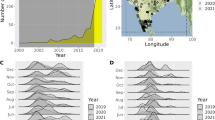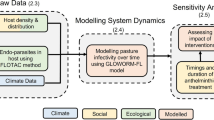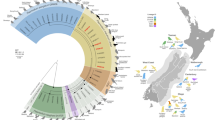Abstract
Whereas migrating birds have been implicated in the spread of West Nile virus (WNV), there is no direct evidence of birds actively migrating while infectious. The role of birds in WNV dispersal is difficult to assess in the field. However, this role can be evaluated experimentally because birds in migratory disposition display increased locomotor activity or restlessness under captive conditions. We tested the following hypotheses: (1) migrating passerine birds continue to exhibit migratory activity while infectious with WNV and (2) the migratory state of the individual affects the magnitude of viremia. We examined the migratory activity of two neoarctic-neotropical passerine migrants, Swainson’s thrush (Catharus ustulatus) and gray catbird (Dumetella carolinensis), during acute WNV infection. All gray catbirds and six of nine Swainson’s thrushes exhibited migratory activity while infectious. Moreover, migratory status did not appear to influence viremia titers, as might be expected if individuals were immunosuppressed during migration. Therefore, we demonstrate that migrating passerine birds are potential dispersal vehicles for WNV.


Similar content being viewed by others
References
Apperson CS, Harrison BA, Unnasch TR, Hassan HK, Irby WS, Savage HM, et al. (2002) Host-feeding habits of Culex and other mosquitoes (Diptera: Culicidae) in the Borough of Queens in New York City, with characters and techniques for identification of Culex mosquitoes. Journal of Medical Entomology 39:777–785
Apperson CS, Hassan HK, Harrison BA, Savage HM, Aspen SE, Farajollahi A, et al. (2004) Host feeding patterns of established and potential mosquito vectors of West Nile virus in the eastern United States. Vector-Borne and Zoonotic Diseases 4:71–82
Austgen LE, Bowen RA, Bunning ML, Davis BS, Mitchell CJ, Chang GJ (2004) Experimental infection of cats and dogs with West Nile virus. Emerging Infectious Diseases 10:82–86
Beaty BJ, Calisher CH, Shope RE (editors) (1995) Diagnostic Procedures for Viral, Rickettsial, Chlamydial Infections, 7th ed. Washington DC: American Public Association
Bernard KA, Maffei JG, Jones SA, Kauffman EB, Ebel G, Dupuis AP 2nd, et al. (2001) West Nile virus infection in birds and mosquitoes, New York State, 2000. Emerging Infectious Diseases 7:679–685
Berthold P (editor) (1975) Migration: Control and Metabolic Physiology. New York: Academic Press
Berthold P (2001) Control of Bird Migration. Oxford: Oxford University Press
Blem CR (1980) The energetics of migration. In: Gauthreaux JSA (editor), Animal Migration, Orientation, and Navigation, New York: Academic Press, pp 175–224
Cimprich DA, Moore FR (editors) (1995) Gray Catbird (Dumetella carolinensis). Philadelphia: Academy of Natural Sciences and American Ornithologists’ Union
Cochran WW (1987) Orientation and other migratory behaviours of a Swainson’s thrush followed for 1500 km. Animal Behavior 35:927–929
Evans Mack D, Yong W (2000) Swainson’s Thrush (Catharus ustulatus). In: The Birds of North America No. 540, Poole A, Gill F (editors), Philadelphia: The Birds of North America, Inc.
Goddard LB, Roth AE, Reisen WK, Scott TW (2002) Vector competence of California mosquitos for West Nile virus. Emerging Infectious Diseases 8:1385–1391
Gwinner E (1986) Circannual Rhythms. Endogenous Annual Clocks in the Organization of Seasonal Processes, Berlin: Springer
Helms CW, Drury WH (1960) Winter and migratory weight and fat field studies on some North American buntings. Bird-Banding 31:1–40
Kerlinger P, Moore FR (1989) Atmospheric structure and avian migration. Current Ornithology 6:109–142
Kilpatrick AM, Kramer LD, Jones MJ, Marra PP, Daszak P (2006) West Nile virus epidemics in North America are driven by shifts in mosquito feeding behavior. PLoS Biology 4:e82
Klenk K, Snow J, Morgan K, Bowen R, Stephens M, Foster F, et al. (2004) Alligators as West Nile virus amplifiers. Emerging Infectious Diseases 10:2150–2155
Komar N (2003) West Nile virus: epidemiology and ecology in North America. Advances in Virus Research 61:185–234
Komar N, Langevin S, Hinten S, Nemeth N, Edwards E, Hettler D, et al. (2003) Experimental infections of North American birds with the New York strain of West Nile virus. Emerging Infectious Diseases 9:311–322
Malkinson M, Banet C, Weisman Y, Pokamunski S, King R, Drouet M, et al. (2002) Introduction of West Nile virus in the Middle East by migrating white storks. Emerging Infectious Diseases 8:392–397
Mattar S, Edwards E, Laguado J, González M, Alvarez J, Komar N (2005) West Nile virus infection in Colombian horses. Emerging Infectious Diseases 11:1497–1498
Molaei G, Andreadis TG, Armstrong PM, Anderson JF, Vossbrink CR (2006) Host feeding patterns of Culex mosquitos and West Nile virus transmission, northeastern United States. Emerging Infectious Diseases 12:468–474
Moore FR, Gauthreaux SA Jr, Kerlinger P, Simons TR (1995) Habitat requirements during migration: important link in conservation. In: Martin TE, Finch DM (editors), Ecology and Management of Neotropical Migratory Birds, New York: Oxford University Press, pp 121–144
Muñoz FJ, Fuente M (2003) Effect of migratory cycle and 17ß-estradiol on splenic leukocyte functions in female black-headed gulls. European Journal of Physiology 445:659–664
Owen J (2004) Avian immune function and the energetic demands of long-distance migration [thesis]. Hattiesburg: University of Southern Mississippi
Peterson AT, Vieglais DA, Andreasen JK (2003) Migratory birds modeled as critical transport agents for West Nile virus in North America. Vector-Borne and Zoonotic Diseases 3:27–37
Rappole JH, Derrickson SR, Hubalek Z (2000) Migratory birds and spread of West Nile virus in the Western Hemisphere. Emerging Infectious Diseases 6:319–328
Rappole JH, Hubálek Z (2003) Migratory birds and West Nile virus. Journal of Applied Microbiology 94:47S-58S
Reisen WK, Chiles RE, Kramer LD, Martinez VM, Eldridge BF (2000) Method of infection does not alter response of chicks and house finches to western equine encephalomyelitis and St. Louis encephalitis viruses. Journal of Medical Entomology 37:250–258
Ringia AM, Blitvich BJ, Koo HY, Van de Wyngaerde M, Brawn JD, Novak RJ (2004) Antibody prevalence of West Nile virus in birds, Illinois, 2002. Emerging Infectious Diseases 10:1120–1124
Turell MJ, Dohm DJ, Sardelis MR, Oguinn ML, Andreadis TG, Blow JA (2005) An update on the potential of North American mosquitoes (Diptera: Culicidae) to transmit West Nile virus. Journal of Medical Entomology 42:57–62
Turell MJ, O’Guinn M, Dohm DJ, Jones JW (2001) Vector competence of North American mosquitos (Diptera: Culcidae) for West Nile virus. Journal of Medical Entomology 38:130–134
Yong W, Moore FR (1993) Relation between migratory activity and energetic condition among thrushes (Turdidae) following passage across the Gulf of Mexico. Condor 95:934–943
Author information
Authors and Affiliations
Corresponding author
Rights and permissions
About this article
Cite this article
Owen, J., Moore, F., Panella, N. et al. Migrating Birds as Dispersal Vehicles for West Nile Virus. EcoHealth 3, 79–85 (2006). https://doi.org/10.1007/s10393-006-0025-9
Published:
Issue Date:
DOI: https://doi.org/10.1007/s10393-006-0025-9




